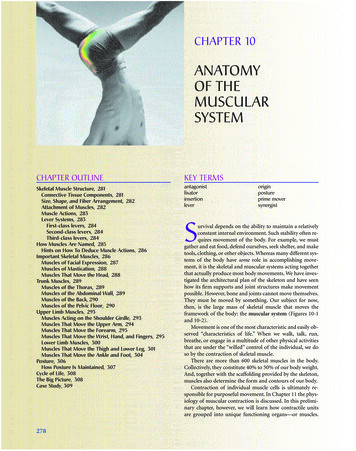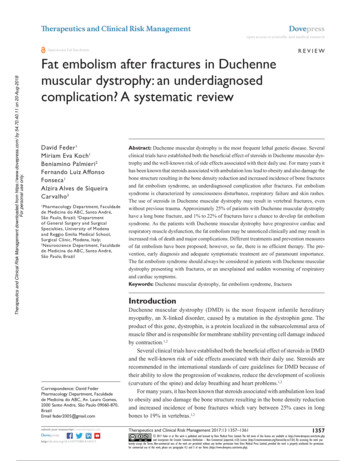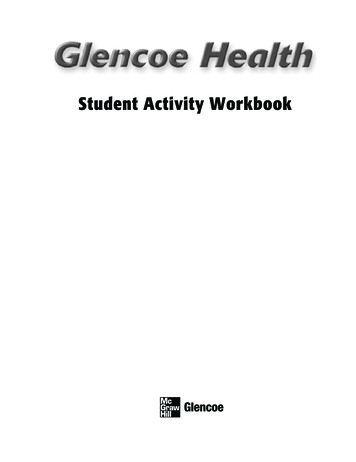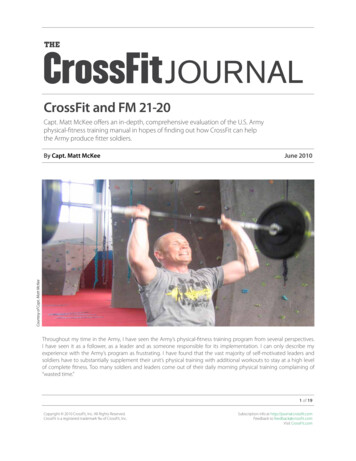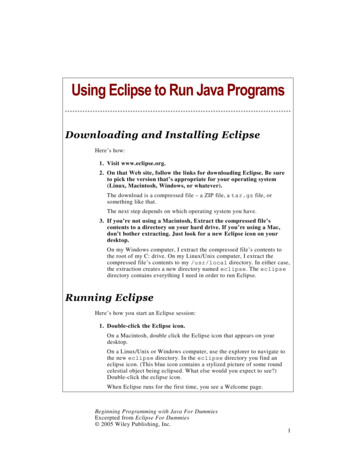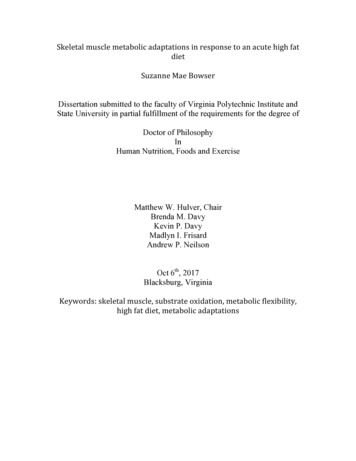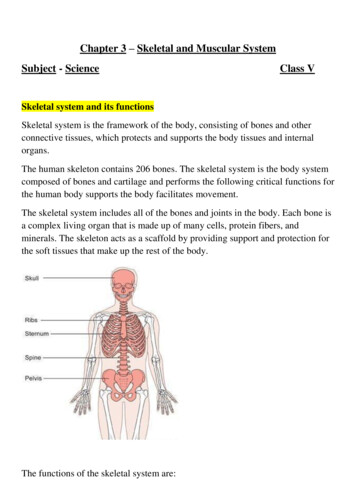
Transcription
Chapter 3 – Skeletal and Muscular SystemSubject - ScienceClass VSkeletal system and its functionsSkeletal system is the framework of the body, consisting of bones and otherconnective tissues, which protects and supports the body tissues and internalorgans.The human skeleton contains 206 bones. The skeletal system is the body systemcomposed of bones and cartilage and performs the following critical functions forthe human body supports the body facilitates movement.The skeletal system includes all of the bones and joints in the body. Each bone isa complex living organ that is made up of many cells, protein fibers, andminerals. The skeleton acts as a scaffold by providing support and protection forthe soft tissues that make up the rest of the body.The functions of the skeletal system are:
1. The skeleton gives shape and support to our body.2. It protects the soft internal organs:(i) The skull protects the brain.(ii) The rib cage protects the heart and the lungs.(iii) The backbone protects the spinal cord.3. It allows the movement of different body parts.4. Many bones in our body are hollow. They are filled with a jelly-likesubstance called bone marrow. Blood cells are made in the bone marrow.
Parts of the skeletonThe different parts of the skeleton system are:1. Skull: The skull acts like a helmet and protect the brain.The skull or known as the cranium in the medical world is a bone structure of thehead. It supports and protects the face and the brain. The adult skull has a total of22 individual bones. They don't move and united into a single unit. The skullperforms vital functions.2. Rib cage: The rib cage protects the heart and lungs. The rib cage is thearrangement of ribs attached to the vertebral column and sternum in the thorax ofmost vertebrates, which encloses and protects the heart and lungs. It has 24 ribsin 12 pairs.The rib cage has three important functions: protection, support and respiration. Itencloses and protects the heart and lungs.The sternum is a long, flat bone that forms the front of the rib cage.
3. Backbone: The backbone surrounds and protects the spinal cord. The spine (orbackbone) runs from the base of the skull to the pelvis. It serves as a pillar tosupport the body's weight and to protect the spinal cord. There are three naturalcurves in the spine that give it an "S" shape when viewed from the side. Thesecurves help the spine withstand great amounts of stress by providing a more evendistribution of body weight.The spine is made up of a series of bones that are stacked like blocks on top ofeach other with cushions called discs in between to help absorb shock/load.
4. Limbs: (Arms and legs) help us in doing many activities and in moving fromone place to another. In the human body, the arms and the legs are commonlycalled the upper limbs and lower limbs respectively, to include part of theshoulder and hip girdles. Arms and legs are connected to torso or trunk. Manyanimals use limbs for locomotion, such as walking, running, or climbing.Structure of a bone
Bones have hard outer layer called cortical (compact) bone, which is strong,dense and tough and spongy inner layer called trabecular (cancellous) bone,which is lighter compared to compact bone. They have their own blood supply aswell as nerves, which help them to grow and repair themselves. That is how theygrow as we get older.Bones are composed of calcium, phosphorus, and a fibrous substance known ascollagen. Bones are strong but light in weight as they are hollow from inside. Thelong bones of the arms and legs, such as the femur (thigh bone), have a centralcavity containing bone marrow. Bone marrow is the flexible tissue in the interiorof bones. In humans, red blood cells are produced by bone marrow. Usually childis born with 300 soft bones. With the growth of child, these bones fuse togetherand an adult person has 206 bones. The smallest bone is stapes which is presentinside our ear. They provide structural support and protect various organs of the body. They produce red blood cells. They enable mobility by acting as levers and points of attachment formuscles. They act as storage for calcium and phosphorus, essential minerals forvarious cellular activities throughout the body.Joints
A Hinge Joint: It is a common class of synovial joint that includes the ankle,elbow, and knee joints. Hinge joints are formed between two or more boneswhere the bones can only move along one axis to flex or extend.A Gliding Joint: It is also known as a plane joint or planar joint, is a commontype of synovial joint formed between bones that meet at flat or nearly flatarticular surfaces.Ball and socket joints: This is the type of joint in which ball shape surface ofone bone fitted into the hollow space of another bone also called socket. In thistype of joint movement can be done in all the directions.Pivot Joint: This type of joint allows movements in many planes, viz. up anddown, side to side movements.Pivotal joints allow for rotation, twisting, extension, and flexibility. This is thejoint where our neck joints head and allow the movement of forward, backward,left and right direction.Saddle joint: It is also known as sellar joints. These highly flexible joints arefound in various places in the body, including the thumb, shoulder, and inner ear.
Muscular system and its functionsThe main function of the muscular system is movement. Muscles are the onlytissue in the body that has the ability to contract and therefore move the otherparts of the body. Related to the function of movement is the muscular system'ssecond function: the maintenance of posture and body position.The main functions of the muscular system are as follows:1. MobilityThe muscular system’s main function is to allow movement. When musclescontract, they contribute to gross and fine movement. Gross movement refers tolarge, coordinated motions and includes: walkingrunningswimming
Fine movement involves smaller movements, such as: writingspeakingfacial expressionsThe smaller skeletal muscles are usually responsible for this type of action. Mostmuscle movement of the body is under conscious control. However, somemovements are reflexive, such as withdrawing a hand from a source of heat.2. StabilityMuscle tendons stretch over joints and contribute to joint stability. Muscletendons in the knee joint and the shoulder joint are crucial in stabilization. Thecore muscles are those in the abdomen, back, and pelvis, and they also stabilizethe body and assist in tasks, such as lifting weights.3. PostureSkeletal muscles help keep the body in the correct position when someone issitting or standing. This is known as posture. Good posture relies on strong,flexible muscles. Stiff, weak, or tight muscles contribute to poor posture andmisalignment of the body. Long-term, bad posture leads to joint and muscle painin the shoulders, back, neck, and elsewhere.4. CirculationThe heart is a muscle that pumps blood throughout the body. The movement ofthe heart is outside of conscious control, and it contracts automatically whenstimulated by electrical signals. Smooth muscle in the arteries and veins plays afurther role in the circulation of blood around the body. These muscles maintainblood pressure and circulation in the event of blood loss or dehydration. Theyexpand to increase blood flow during times of intense exercise when the bodyrequires more oxygen.5. RespirationBreathing involves the use of the diaphragm muscle. The diaphragm is a domeshaped muscle located below the lungs. When the diaphragm contracts, it pushesdownward, causing the chest cavity to get bigger. The lungs then fill with air.When the diaphragm muscle relaxes, it pushes air out of the lungs. Whensomeone wants to breathe more deeply, it requires help from other muscles,including those in the abdomen, back, and neck.
6. DigestionSmooth muscles in the gastrointestinal or GI tract control digestion. The GI tractstretches from the mouth to the anus. Food moves through the digestive systemwith a wave-like motion called peristalsis. Muscles in the walls of the holloworgans contract and relax to cause this movement, which pushes food through theesophagus into the stomach. The upper muscle in the stomach relaxes to allowfood to enter, while the lower muscles mix food particles with stomach acid andenzymes. The digested food moves from the stomach to the intestines byperistalsis. From here, more muscles contract to pass the food out of the body asstool.7. UrinationThe urinary system comprises both smooth and skeletal muscles, including thosein the: bladderkidneyspenis or vaginaprostateuretersurethraThe muscles and nerves must work together to hold and release urine from thebladder.Urinary problems, such as poor bladder control or retention of urine, are causedby damage to the nerves that carry signals to the muscles.8. ChildbirthSmooth muscles in the uterus expand and contract during childbirth. Thesemovements push the baby through the vagina. Also, the pelvic floor muscles helpto guide the baby’s head down the birth canal.9. VisionSix skeletal muscles around the eye control its movements. These muscles workquickly and precisely, and allow the eye to: maintain a stable imagescan the surrounding area
track moving objectsIf someone experiences damage to their eye muscles, it can impair their vision.10. Organ protectionMuscles in the torso protect the internal organs at the front, sides, and back of thebody. The bones of the spine and the ribs provide further protection. Musclesalso protect the bones and organs by absorbing shock and reducing friction in thejoints.11. Temperature regulationMaintaining normal body temperature is an important function of the muscularsystem. Almost 85 percent of the heat a person generates in their body comesfrom contracting muscles. When body heat falls below optimal levels, theskeletal muscles increase their activity to make heat. Shivering is one example ofthis mechanism. Muscles in the blood vessels also contract to maintain bodyheat. Body temperature can be brought back within normal range through therelaxation of smooth muscle in the blood vessels. This action increases bloodflow and releases excess heat through the skin.
Different types of muscles
QUESTION & ANSWERQ1. What is the skeletal system? Name the parts of the skeletal system.A1. The skeletal system is the body system composed of bones and cartilage andperforms the following critical functions for the human body: supports the body,facilitates movement and protects internal organs.Q2. What are the functions of the skeleton?A2. The functions of the skeletal system are:1. The skeleton gives shape and support to our body.2. It protects the soft internal organs:(i) The skull protects the brain.
(ii) The rib cage protects the heart and the lungs.(iii) The backbone protects the spinal cord.3. It allows the movement of different body parts.4. Many bones in our body are hollow. They are filled with a jelly-likesubstance called bone marrow. Blood cells are made in the bone marrow.Q3. What is a joint?A3. A joint is the connection made between bones in the body which link theskeletal system into a functional whole. They are constructed to allow fordifferent degrees and types of movement. Joints are classified both structurallyand functionally.Q4. Differentiate between movable and immovable joints.A4.Q5. Why are at least two muscles needed to move any joint in the body?
A5. Generally, two skeletal muscles are joined to one bone, so that when onemuscle contracts in one direction for enabling the bone to move in that specificdirection; the other muscle becomes relaxed to facilitate the movement of thebone.Q6. Why is posture important?A6. Good posture relies on strong, flexible muscles. Stiff, weak, or tight musclescontribute to poor posture and misalignment of the body. Long-term, bad postureleads to joint and muscle pain in the shoulders, back, neck, and elsewhere.
the human body supports the body facilitates movement. The skeletal system includes all of the bones and joints in the body. Each bone is a complex living organ that is made up of many cells, protein fibers, and minerals. The skeleton acts as a scaffold by providing support and protection for the soft ti

